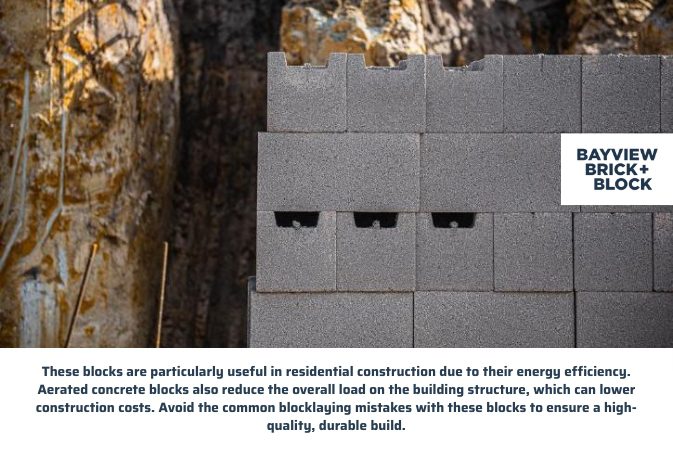Choosing the right type of block is essential for any construction project, as each block offers unique benefits depending on the requirements. In this article, we’ll discuss the most commonly used blocks in blocklaying, including concrete blocks, aerated concrete blocks, stone blocks, splitface blocks, and rendered blocks. We’ll explore their specific properties, such as strength, insulation, and aesthetics, and explain how each type can influence the overall outcome of your construction project.
Concrete Blocks
Concrete blocks, also called masonry blocks, are among the most common materials in construction used by blocklayers. Commercial builders prefer them for their strength and durability. They come in various sizes, making them versatile for different projects. Hollow concrete blocks, with their voids, allow for better insulation and lighter weight.
Solid concrete blocks provide more strength and stability. Concrete blocks often find use in foundation work, walls, and other structural applications. They are easy to work with and can be laid quickly, making them efficient for large-scale projects.
Aerated Concrete Blocks
Aerated concrete blocks, also known as AAC (Autoclaved Aerated Concrete) blocks, are lightweight and provide excellent insulation. Their cellular structure makes them easier to cut and shape than traditional concrete blocks. Builders value their fire resistance and soundproofing qualities.
These blocks are particularly useful in residential construction due to their energy efficiency. Aerated concrete blocks also reduce the overall load on the building structure, which can lower construction costs. Avoid the common blocklaying mistakes with these blocks to ensure a high-quality, durable build.

Stone Blocks
Stone blocks offer a natural and timeless aesthetic. Each block has unique textures and colours, providing a distinctive look for any project. Builders often use them in retaining walls, garden edging, and decorative facades. Stone blocks come in various types, such as sandstone, limestone, and granite.
These materials offer exceptional durability and can withstand harsh weather conditions. Stone blocks require precise laying techniques to ensure stability and longevity, often demanding skilled labour. Their robust nature makes them a preferred choice for projects where longevity is a priority.
Splitface Blocks
Splitface blocks bring texture and dimension to any construction project. Their rough, uneven surface mimics natural stone, adding visual interest. These blocks are often used for decorative purposes on exterior walls and facades. They come in a variety of colours and sizes, allowing for creative design options.
The manufacturing process involves splitting a single block into two, creating a rough-hewn look. Splitface blocks are durable and resistant to weathering, making them suitable for both residential and commercial projects. Proper installation ensures the aesthetic appeal and structural integrity of these blocks.
Rendered Blocks
Rendered blocks provide a smooth finish that can be painted or textured. They offer a versatile solution for achieving a clean, modern look. Rendering involves applying a coat of cement or lime-based plaster to the block surface. This process not only improves appearance but also adds a layer of protection against the elements.
Rendered blocks are often used in both interior and exterior applications. They can hide imperfections and create a uniform look. Proper rendering technique is crucial to avoid cracks and ensure a long-lasting finish.

